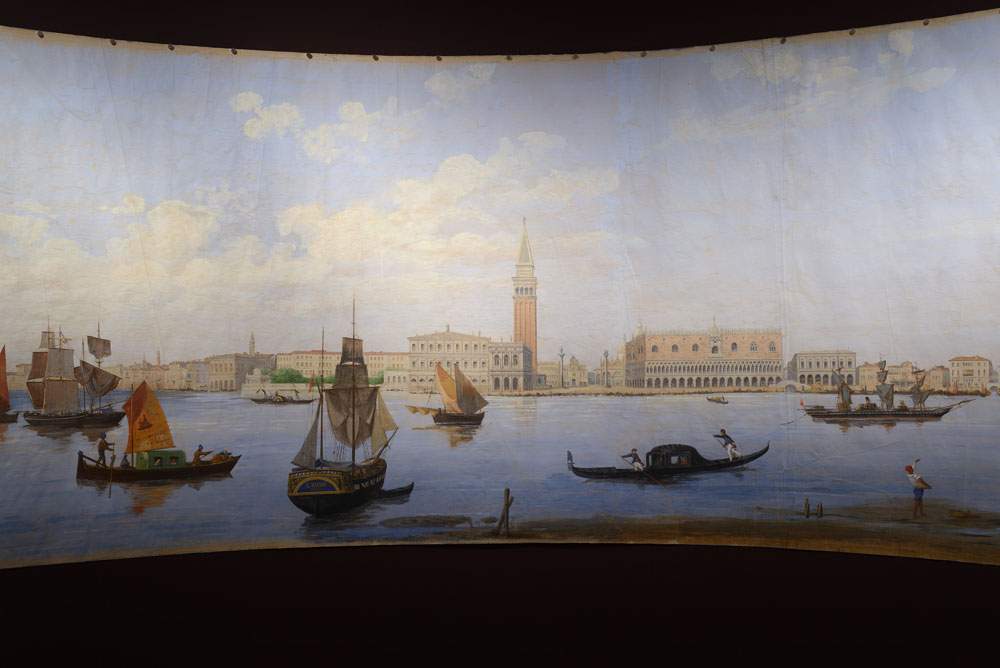Venice, the city's largest view is on display for the first time at Querini Stampalia
On display for the first time at the Fondazione Querini Stampalia in Venice is the largest view of Venice ever made, completed in 1887 by Venetian painter and decorator Giovanni Biasin. Kept in the collections of theAccademia dei Concordi in Rovigo, it can now be seen for the first time after the very recent conservative restoration. The work has truly monumental dimensions: just over five feet high, the view is twenty-two meters long. Around this extraordinary view develops the exhibition promoted by Fondazione Querini Stampalia, Accademia dei Concordi and Fondazione Cariparo entitled Venezia panoramica. The discovery of the infinite horizon, curated by Giandomenico Romanelli and Pascaline Vatin.
The exhibition stems from the desire to present Biasin’s original view of the city in Venice, more than a century later, but it is also an opportunity to reconstruct, through about sixty engravings and paintings, that journey that starts from tiny 15th-century woodcut vignettes, centered almost only on St. Mark’s Square, and gradually expands to ever larger views of the Venice skyline, until it embraces the entire horizon. Using a long roll of reinforced paper and making use of very vivid tempera colors, Biasin depicted Venice in 360 degrees. The shooting point, at water level, is approximately the center of St. Mark’s Basin, although the artist introduced variations and perspective forcing for a more effective portrait of the city. Beginning at the Giardini di Castello and continuing around, then returning by closing the circle, the artist animated his view by insertingdetails of monuments, buildings, gardens and boats to give the whole a light and narrative tone. Even today it is still possible to realize exactly what his impressions were: one has to mount the panorama on a large drum around the viewer and here is an evocative view of late 19th-century Venice. The scene is vivid and full of figures and moments of life that render the most faithful pictorial image of late 19th century Venice.
The exhibition also traces, through pivotal works, the developments that led to the birth, in the late eighteenth century, of the term ’panorama’ and the works that determined its fortune: from Erhard Reuwich’s celebrated woodcut of the late fifteenth century to the extremely rare face of Venice traced by Giovanni Merlo in the seventeenth century. From the elaborations between the seventeenth and eighteenth centuries of a curious Venice with a Nordic face to the nineteenth-century panoramas of the most famous engravers, up to the present day.
Caffi, Moro, Pividor and other artists thus testify in the exhibition to the fortunes of a genre and bring to the public’s admiration a package of little-known or even unknown works that for the first time can also be juxtaposed and compared with each other. The exhibition concludes with the plates of Guido Albanello, who takes up the challenge of the tried-and-true panoramists of the 19th century in 2004.
The catalog, published by Lineadacqua, traces the history of the panorama, from medieval vignettes to the Lumière brothers’ filming in the late 19th century. Ample space is devoted to Giovanni Biasin’s giant Panorama of Venice and its possible models: the views engraved or lithographed by specialists in the genre such as Ippolito Caffi, Antonio Lazzari, Giovanni Pividor and Marco Moro; the very large panoramas made for the most important European art exhibitions; the dioramas and the like that went from city to city for the entertainment of the most curious without forgetting the works of the 18th-century vedutisti, first and foremost Canaletto. Enriching the volume is a comprehensive catalog of the works that contributed to the development of the genre over the centuries. Texts by Giandomenico Romanelli, Pascaline Vatin and Carlo Montanaro.
For info: www.querinistampalia.org
Hours: Tuesday through Sunday from 10 a.m. to 6 p.m. Closed Mondays.
Tickets: Full 14 euros, reduced 10 euros. The visit to the exhibition is included in the entrance ticket to the Fondazione Querini Stampalia.
 |
| Venice, the city's largest view is on display for the first time at Querini Stampalia |
Warning: the translation into English of the original Italian article was created using automatic tools. We undertake to review all articles, but we do not guarantee the total absence of inaccuracies in the translation due to the program. You can find the original by clicking on the ITA button. If you find any mistake,please contact us.




























